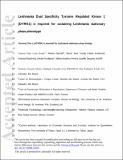Leishmania dual specificity tyrosine regulated kinase 1 (DYRK1) is required for sustaining Leishmania stationary phase phenotype
Abstract
Although the multiplicative and growth‐arrested states play key roles in Leishmania development, the regulators of these transitions are largely unknown. In an attempt to gain a better understanding of these processes, we characterised one member of a family of protein kinases with dual specificity, LinDYRK1, which acts as a stasis regulator in other organisms. LinDYRK1 over‐expressing parasites displayed a decrease in proliferation and in cell cycle re‐entry of arrested cells. Parasites lacking LinDYRK1 displayed distinct fitness phenotypes in logarithmic and stationary growth phases. In logarithmic growth‐phase, LinDYRK1‐/‐ parasites proliferated better than control lines, supporting a role of this kinase in stasis, while in stationary growth‐phase, LinDYRK1‐/‐ parasites had important defects as they rounded up, accumulated vacuoles and lipid bodies and displayed subtle but consistent differences in lipid composition. Moreover, they expressed less metacyclic‐enriched transcripts, displayed increased sensitivity to complement lysis and a significant reduction in survival within peritoneal macrophages. The distinct LinDYRK1‐/‐ growth phase phenotypes were mirrored by the distinct LinDYRK1 localisations in logarithmic (mainly in flagellar pocket area and endosomes) and late stationary phase (mitochondrion). Overall, this work provides first evidence for the role of a DYRK family member in sustaining promastigote stationary phase phenotype and infectivity.
Citation
Rocha , V P C , Dacher , M , Young , S A , Kolokousi , F , Efstathiou , A , Späth , G F , Pereira Soares , M B & Smirlis , D 2020 , ' Leishmania dual specificity tyrosine regulated kinase 1 (DYRK1) is required for sustaining Leishmania stationary phase phenotype ' , Molecular Microbiology , vol. Early View . https://doi.org/10.1111/mmi.14464
Publication
Molecular Microbiology
Status
Peer reviewed
ISSN
0950-382XType
Journal article
Description
This work was supported by the International Division of the Institute Pasteur (ACIP A13-2013 project), the Action “KRIPIS I” (MIS 450598) co-financed by European Union and the National Ministry of Education and Religion Affairs under the Operational Strategic Reference Framework (NSRF 2007-2013) and the General Secretariat of Research and Technology (GSRT) and FAPESB/CAPES grant # PET0042/2013 from the Brazilian State and Federal governments respectively.Collections
Items in the St Andrews Research Repository are protected by copyright, with all rights reserved, unless otherwise indicated.

